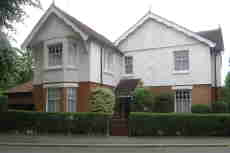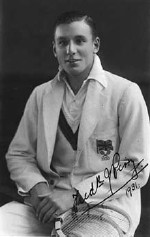Wimbledon Champion Fred Perry Lived Here
Application for blue plaque status reaches shortlist
|
The former Ealing home of Britain's most celebrated tennis player, Fred Perry, is a step closer to getting a blue plaque.

Brentham Heritage Society applied to English Heritage for the famous wall plaque and has just heard they have reached the shortlist.
The imposing corner house at 223 Pitshanger Lane was his family home from 1918 until he moved permanently to the US after his first marriage in 1935.
It was in Brentham that he first discovered and developed his sporting talents.
Fred Perry won Wimbledon three times in succession in
1934, 1935 and 1936. No Briton has equalled his record, before or since.
An exceptional amateur and professional sportsman, his name lives on for succeeding generations because of the sportswear range he founded.
The Brentham Society is a registered charity with the objective of informing the public about the historical and architectural heritage of Brentham Garden Suburb of which 223 Pitshanger Lane forms part.
It wants Fred Perry’s association with this historic enclave
and its critical role in his sporting achievements to be recognised with a Blue Plaque.
His statue stands in the grounds of Wimbledon and a Borough of Stockport plaque commemorates his birthplace.
Sue Elliott, Chair of The Brentham Society is hopeful that there will soon be another in Ealing.
She says: ''
This is not a guarantee of one, but if all proceeds smoothly, it should be installed in time for Olympics year, 2012.''
Biographical background
Frederick John Perry was born in Stockport on 18 May 1909, the son of Sam and Hannah Perry. Sam was a cotton spinner of humble origins who successfully carved out a political career within the Co-operative movement, becoming Labour/Co-operative MP for Kettering twice, in 1923 and 1929.
It was Sam’s work in the Co-operative movement that prompted the family’s move to Brentham from the North-west at the end of the First World War. After building a name for himself in Manchester politics, Methodism and the Temperance movement, in 1918 Sam was appointed the first Secretary of the newly founded Co-operative Party, and established its headquarters near Charing Cross station.
Brentham Garden Suburb in Ealing wasn’t particularly convenient for his work, but it was an obvious fit with his political and social ideals. Brentham had started in 1901 as a Co-partnership housing development, building decent homes for rent by working people who owned shares in the building company, Ealing Tenants Ltd., and enjoyed its ‘profits’ in the form of subsidised rents. It was a form of co-operation to which Sam Perry could easily subscribe, and it offered his family a well built home in a ready-made community where social, sporting and recreational facilities were part of the package. Every house had its garden, there were allotments, and the Brentham Institute offered a packed programme of clubs and activities, and excellent sports facilities. As a keen sportsman, committed socialist and gregarious human being, Sam Perry must have viewed 223 Pitshanger Lane and Brentham Garden Suburb the ideal place to start his family’s new life in the south.
For young Fred, “It was paradise. For a kid coming from the north it was marvellous… you had your own institute and club house… you had your kids’ activities, your whist, your billiards. You had dances, meetings and parties. I was only about nine when I first went there. But to have the football, cricket and tennis which I didn’t play at that time, and the table tennis and the bowls all included… the club was a community centre. Everybody knew everybody else… There was always somebody to play with and older people would help you.”
Fred always acknowledged the part Brentham and its Institute played in his subsequent sporting career: “It was there that I first became interested in watching and playing sport”. Childhood friends on the estate remember that he showed no interest in tennis at first: like many of his contemporaries his boyhood ambition was to play for Aston Villa, and his first significant sporting achievement was in table tennis, when he became world champion in 1929 at the age of 19. But by then he was also fascinated by tennis and had qualified for Wimbledon for the first time in that year, winning through two rounds of the main draw.
He developed his distinctive technique at the Institute and at 223 Pitshanger Lane: “I used to practise tennis on the bowling green at the Institute if the tennis courts weren’t free. I used to practise against walls. Walls don’t break down, you do. I used to hit the ball against a garage door. We were lucky we had a garage, but from about 20 feet. It’s only to help the racket become part of you, which it has to do. Getting rhythm, the timing and the parabola of the ball in both table tennis and tennis were the same. I used the kitchen wall for my table tennis and the garage door for my tennis. I also used a greenhouse which I used to hit over onto the wall. We didn’t have too many windows left when I’d finished!”
After joining the Herga Club in Harrow and then the Chiswick Park Club, he dedicated himself exclusively to perfecting his tennis game and rose swiftly to prominence, as a Davis Cup finalist in 1931 and as part of the winning British Davis Cup team in 1933, 1934, 1935 and 1936. He also won the French, US and Australian championships.
With thanks to Sue Elliott
Chair, Brentham Heritage Society
July 1, 2009
